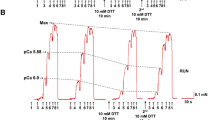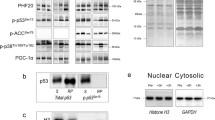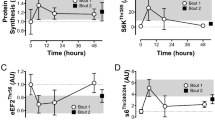Abstract
The purpose of this study was to examine the Ca2+-Mg2+ myofibrillar ATPase and protein composition of cardiac and skeletal muscle following strenuous activity to voluntary exhaustion. Sprague-Dawley rats (200 g) were assigned to a control and exercised group, with the run group completing 25 m·min−1 and 8% grade for 1 hour. Following activity, the myocardial Ca2+−Mg2+ myofibrillar ATPase activity -pCa relationship had undergone a rightward shift in the curve. Electrophoretic analysis revealed a change in the pattern of cardiac myofibrillar protein bands, particularly in the 38–42 Kdalton region. Enzymatic analysis of myofibrillar proteins from plantaris muscle, revealed no change in Ca2+ regulation following exercise. Electronmicrographic and electrophoretic analysis revealed extensively disrupted sarcomeric structure and a change in the ratio of several plantaris myofibrillar proteins. No difference was observed for myosin: Actin: tropomyosin ratios; however a dramatic reduction in 58 and 95 Kdalton proteins were evident. The results indicate that prolonged running is associated with similar responses in cardiac and skeletal muscle myofibrillar protein compositions. The abnormalities in myofibrillar ultrastructure may implicate force transmission failure as a factor in exercised-induced muscle damage and/or fatigue.
Similar content being viewed by others
References
Friden J, Sjostrom M, Ekblom B: Myofibrillar damage following intense eccentric exercise in man. Int J Sports Med 3: 170–176, 1983
Belcastro AN, MacLean I, Gilchrist J: Biochemical basis of muscle fatigue associated with repetitious contractions of skeletal muscle. Int J Biochem 17: 447–453, 1985
Sembrowich WL, Johnson D, Wang E, Hutchinson TE: Electron microprobe analysis of fatigued fast- and slow-twitch muscle. In: Knuttgen, HG, Vogel, JA and Poortmans J (ed) Int Series on Sport Sci: Biochemistry of Exercise. Human Kinetics Pub., Champaign, Il., U.S.A., 1983, 13, pp 571–576
Vikko V Salminen A, Rantamaki J: Acid hydrolase activity in red and white skeletal muscle of mice during a two week period following exhaustive exercise. Pflugers Arch 378: 99–106, 1978
Duncan CJ, Greenway HC, Smith JL: 2,4-Dinitrophenol, lysosomal breakdown and rapid myofilament degradation in vertebrate skeletal muscle. Arch Pharmacol. 315: 77–82, 1980
Belcastro AN, Turcotte R, Rossiter M, Secord D, Maybank PE: Myofibril ATPase activity of cardiac and skeletal muscle of exhaustively exercised rats. Int J Biochem 16: 297–303, 1984
Maher JT, Goodman AL, Francesconi R, Bowers WD, Hartley LH, Angelakos ET Responses of the rat myocardium to exhaustive exercise. Am J Physiol 222: 207–212, 1972
King DW, Gollnick PD: Ultrastructure of rat heart and liver after exhaustive exercise. Am J Physiol. 218: 1150–1155, 1970
Lowry OH, Rosebrough NJ, Farr AL, Randall AJ: Protein measurement with the folin phenol reagent. J Biol Chem 193: 265–275, 1951
Taussky HH, Shorr EA: A microcolorimetric method for the determination of inorganic phosphate. J Biol Chem 202: 675–685, 1953
Bers DM: A simple method for the accurate determination of free [Ca] in Ca-EgTA solutions. Am J Physiol 242: C404-C408, 1982
Rupp H: Modulation of tension generation at the myofibrillar level — an analysis of the effect of magnesium adenosine triphosphate, magnesium, pH, sarcomere length and state of phosphorylation. Basic Res Cardiol 75: 157–162, 1980
Laemmli UK, Cleavage of structural proteins during the assembly of the head of bacteriophage T4. Nature 227: 680–685, 1970
Merril CR, Pratt ME: A silver stain for the rapid quantitative detection of proteins or nucleic acids. Anal Biochem 156: 96–110, 1986
Friden J: Changes in human skeletal muscle induced by longterm eccentric exercise. Cell Tissue Res 236: 365–372
Price HM: The Striated Muscle (Pearson CM, Mostofi FK, ed.) pp. 144–184, Williams and Wilkens Co., Baltimore, 1973
Neville HE: Muscle Biopsy: A Modern Approach, (Dubowitz V, Brooke MH, Neville HE, ed.) pp. 383–444, WB Saunders Co., Toronto, 1973
Street SF: Lateral transmission of tension in frog myofibers. A myofibrillar network and transverse cytoskeletal connections are possible transmitters. J Cell Physiol 114: 346–364, 1983
Edinger JD, Zak R, Fischman DA: Compositional studies of myofibrils from rabbit striated muscle. J Cell Biol 68: 123–141, 1976
Goldspink G: The proliferation of myofibrils during muscle fiber growth. J Cell Sci 6: 593–604, 1970
Lewis SEM, Anderson P, Goldspink DF: The effects of calcium on protein turnover in skeletal muscles of the rat. Biochem J 204: 257–264, 1982
Reddy MK, Robinowitz M, Zak R: Stringent requirement for Ca2+ in the removal of Z-line and -actinin from isolated myofibrils by a Ca2+ -activated neutral proteinase. Biochem J 209: 635–641, 1983
Dayton WR, Reville WD, Goll DE, Stromer MH: A Ca2+-activated protease possibly involved in myofibrillar protein turnover. Partial characterization of the purified enzyme
Belcastro AN, Rossiter M, Low MP, Sopper MM: Calcium activation of sarcoplasmic reticulum ATPase activity following strenuous activity. Can J Physiol Pharmacol 59: 1214–1218, 1981
Holroyde MJ, Howe E, Solaro RJ: Modification of calcium requirements for activation of cardiac myofibrillar ATPase by CAMP dependent phosphorylation. Biochem Biophys Acta 586: 63–69, 1979
Goldfarb AH Kenduck ZV: Effect of an exercise run to exhaustion on CAMP in the rat heart. J Appl Physiol 51: 1539–1542, 1981
Robertson SP, Johnson JD, Holroyde MJ, Kranias EG, Potter JD, Solaro RJ: The effect of TNI phosphorylation on the state and kinetic Ca2+ binding of cardiac TNC. J Biol Chem 257: 260–263, 1982
Solaro RJ, Kumar P, Blanchard EM, Martin AF: Differential effects of pH on calcium activation of myofilaments of adult and perinatal dog hearts. Circ Res 58: 721–729, 1987
Pierce GN, Kutryk MJB, Dhalla KS, Beamish RE, Dhalla NS: Biochemical alterations in heart after exhaustive swimming in rats. J Appl Physiol 57: 326–331, 1984
Author information
Authors and Affiliations
Rights and permissions
About this article
Cite this article
Belcastro, A.N., Parkhouse, W., Dobson, G. et al. Influence of exercise on cardiac and skeletal muscle myofibrillar proteins. Mol Cell Biochem 83, 27–36 (1988). https://doi.org/10.1007/BF00223195
Received:
Accepted:
Issue Date:
DOI: https://doi.org/10.1007/BF00223195




